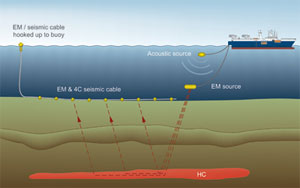簡介:一種可以同時進行兩項測量的海底電纜系統,該系統融合傳統地震方式和電磁感應于一體,利用單根電纜進行海底油氣藏的定位和描述。該系統在挪威海上進行了現場測試,取得的結果超出預期。
A seabed system is working to take both measurements at the same time.

A new exploration, field development, and field monitoring technology has been developed that combines the strengths of conventional seismic and electromagnetic (EM) sensing into a single seafloor cable to locate and delineate hydrocarbon reservoirs.
This combined approach is a result of a research activity that originated in Hydro O&E (now StatoilHydro) Research Centre in Bergen, Norway, in 2002, and led to the formation of Marine Services, now MultiField Geophysics, in November 2006 with Hydro Technology Ventures (now StatoilHydro Ventures), Wavefield Inseis ASA (now part of CGGVeritas), and the Norwegian Geotechnical Institute as owners.
While conventional seismic methods offer the best means to map the subsurface structural geometry, EM waves often identify reservoir fluids better than seismic compressional (P) waves. EM data acquired in combination with seafloor seismic (P and shear waves) are considered the best way of determining hydrocarbon probability.
In February 2007 the technology was first tested out in Sognefjord, and extensive field trials were then performed over the North Sea Peon gas discovery during a two-week test period in April/May 2008. The operation went very well and resulted in the acquisition of a large amount of densely sampled and high-quality electric, magnetic, and seismic data. The large amount of recorded data will be used to further optimize the acquisition configuration.
The concept
The patented MultiField Geophysics EM concept is illustrated in Figure 1.
Operationally this acquisition concept allows:
• One combined vessel and outlay for both EM and seabed seismic;
• Real-time quality control onboard the vessel; and
• Variable length and spacing of electric field receiver antennas for improved recording sensitivity.
The proprietary EM source has the ability to transmit various GPS synchronized waveforms and frequencies. Numerous signal parameters were tested on the Peon discovery. This was primarily done to test for fulfillment of specifications, but in addition various research data were recorded. The prototype source performance was impressive, and it displayed excellent repeatability.
This patented seabottom cable concept allows the customer to take advantage of EM waves in combination with seismic waves. Inline or multi-azimuth recordings utilizing this integrated ocean-bottom cable (OBC) concept can improve the understanding of subsurface structures and stratigraphic traps through:
• Lithological modeling and fluid predictions;
• Discrimination between real and false direct hydrocarbon indicators;
• Analysis of complex overburden and/or shallow gas; and
• Mapping of anisotropy.
Field test
The system was tested offshore Norway on the Peon discovery. This is a shallow reservoir at around a 1,245-ft (380-m) water depth. Instead of one continuous long cable, five 984-ft (300-m) sections were deployed with a .9-mile (1.5-km) separation along a northwest-southeast profile. Each of the cable sections contained two magnetometers, two four-component seismic sensors, six E-field receivers with an 82-ft (25 m) antenna length, and one E-field receiver with a 902-ft (275-m) antenna length. In addition, one cable section was used for streamer tests.
Peon test objectives were to:
• Compare EM seabed cable data to existing node technology;
• Compare the signal-to-noise ratio for the long and short electric field receivers;
• Study the quality of the magnetic recordings;
• Investigate effects of source height;
• Prove the concept of integrated seismic receivers; and
• Conduct streamer tests.
The operation went very smoothly. Within a two-week period this allowed acquisition of 27 different datasets consisting of combinations of survey parameters: waveform, frequency, tow orientation of EM and seismic sources, etc. The result is an excellent database for evaluation and further optimization of hardware and acquisition configuration.
A cable concept allows much denser sensor spacing compared to single receivers or nodes. Within each cable segment the E-field receivers showed a remarkable consistency (Figure 2), and detailed analysis indicates that the minor variations between them are due to subsurface variations. This adds confidence in the value of dense sampling.
Since an OBC can be placed at the sea bottom along a profile with known orientation, only one inline component of the electric field is needed for detection of high-resistivity gas or oil reservoirs in the subsurface. Single instruments or nodes are allowed to sink and rotate freely through the water column during deployment, requiring two crossed horizontal receivers to calculate the inline E-field component. A recording cable system may also be less vulnerable to seabed irregularities.
During the Peon test, a state-of-the-art EM node was located adjacent to one of the cable segments as a reference. The node deployment was performed with a crane and the 33-ft (10 m) antennas oriented perfectly inline with assistance from a remotely operated vehicle. The field test results show that the long and short cable E-field receivers gave a clearer signal with less noise (Figure 3) than the reference node (33-ft antenna length).
Since the data acquisition was performed across the field boundary to the northwest, the magnitude ratio for each receiver between in-tow and out-tow was computed as a function of source-receiver offset. On Peon these results could assist in delineating the hydrocarbon extension in this area.
A towed EM streamer was also deployed during the Peon test. Signals were recorded, but it was no surprise the signal/noise ratio was seen as a major challenge. This noise problem will have to be solved to allow streaming to become a relevant EM acquisition method. Research is ongoing to achieve this goal through specialized data processing and improved cable design.
Conclusion
The offshore testing of a new seafloor cable for EM and seismic applications resulted in the acquisition of a large amount of densely sampled and high-quality electric, magnetic, and seismic data. The large amount of recorded data forms the basis for ongoing research activities. The Peon test results were in some respects beyond expectations, but nevertheless some areas of improvements were identified, and the full benefit of this R&D effort will be realized in the final design of a commercial system. In general we are encouraged by the successful test results and are focusing on becoming a full-range EM service provider.
